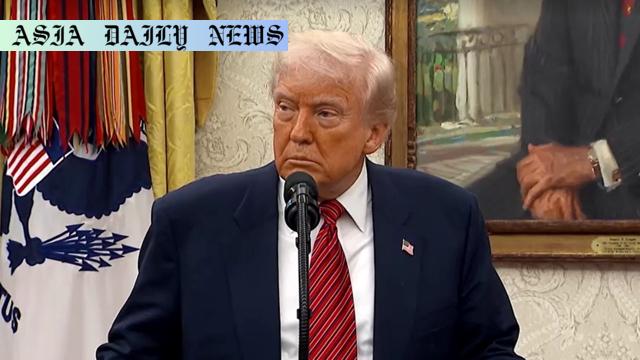Tariffs – US President Donald Trump remains firm on not lowering the 145% tariffs on Chinese goods before trade talks in Switzerland.
- US President Donald Trump ruled out reducing the 145% tariffs on Chinese goods before trade talks in Switzerland.
- The talks are scheduled for this weekend, and high-profile negotiators from both the US and China will be present.
- Trump emphasized the US trade deficit with China but maintained that the US economy is unaffected by sluggish trade.

Trump’s Decision on Tariffs: No Concessions Ahead of Talks
In a statement that has captured the attention of global markets, US President Donald Trump declared that he would not lower the 145% tariffs imposed on Chinese goods ahead of the upcoming trade negotiations in Switzerland. Speaking at the White House on Wednesday, Trump firmly rejected any notion of reducing these levies as a gesture to bring China to the bargaining table. His stance underscores the administration’s hardline strategy in addressing the United States’ trade imbalance with China, an issue that has been at the forefront of his economic policy.
The US-China trade war has been one of the most significant economic conflicts of recent times, with both nations imposing tit-for-tat tariffs exceeding 100% on a wide array of goods. These measures have not only intensified tensions but have also led to considerable uncertainty in global trade markets. With US Treasury Secretary Scott Bessent and US Trade Representative Jamieson Greer representing Washington, and Vice Premier He Lifeng leading the Chinese delegation, the weekend discussions are eagerly anticipated. However, Trump’s decision to maintain the tariffs suggests that the United States is entering this dialogue from a position of strength.
The Larger Context: Trade Imbalance and Economic Impacts
Trump has consistently drawn attention to the nation’s large trade deficit with China, presenting it as a key reason for his administration’s aggressive tariff policies. “You know what we’re losing now? Nothing. That’s not bad,” Trump remarked, reaffirming his belief that the US economy remains unscathed despite the trade war. While this assertion may seem overly optimistic, it reflects the administration’s confidence in its economic resilience and strategic leverage in negotiations.
Observers argue that maintaining high tariffs is a calculated risk, leveraging pressure on China to make substantial concessions during these talks. Yet, there are concerns about the lingering economic implications, particularly for industries and sectors reliant on Chinese imports. Businesses facing increased costs due to tariffs may find themselves in a precarious position if the stalemate continues. The stakes for both nations remain high, and the upcoming negotiations could set a crucial precedent for future trade relations.
What Lies Ahead in the Switzerland Talks?
The scheduled trade talks in Switzerland provide a critical opportunity for both sides to ease tensions and make meaningful progress. Vice Premier He Lifeng, known for his expertise in economic policy, is expected to present proposals aimed at addressing the stalemate. However, President Trump’s firm stance on tariffs indicates that the US will demand significant concessions from Beijing before even considering any reduction in levies.
Market analysts and global observers will be closely monitoring these discussions, as their outcome could have far-reaching implications for the global economy. Will both nations be able to reach a consensus, or will these talks further entrench their positions? Only time will reveal if this chapter of the trade war ends with compromise or confrontation.



Commentary
Trump’s Stance on Tariffs: A Polarizing Decision
President Trump’s decision to stand firm on the 145% tariffs on Chinese goods underscores his commitment to safeguarding American economic interests. However, this inflexible approach has elicited a complex response, both domestically and internationally. While some view this move as a show of strength and resolve, others question its long-term viability and the extent of its collateral damage to businesses and consumers.
On one hand, Trump’s strategy highlights a critical economic issue that has long plagued the United States—its large trade deficit with China. Trump’s firm stance resonates with his “America First” agenda, portraying him as a leader unwilling to compromise on protecting domestic industries. Yet, it is worth considering the economic strain placed on industries and sectors reliant on Chinese imports. The ripple effects of these tariffs could lead to higher costs for businesses and consumers, potentially negating the intended benefits of the policy.
Potential Risks and Opportunities
While the tariffs are undoubtedly a powerful bargaining chip, their prolonged implementation may prove to be a double-edged sword. The global economy, already grappling with uncertainties, faces added strain from the US-China trade standoff. Moreover, businesses reliant on global supply chains are being forced to adapt, often at significant expense. These challenges underscore the need for a balanced approach that considers both strategic objectives and economic realities.
Nevertheless, the upcoming talks in Switzerland present a unique opportunity for progress. With high-profile negotiators on both sides, there is hope for a resolution that balances the interests of both nations. If approached constructively, these discussions could pave the way for a more equitable trade relationship and bring stability to global markets.